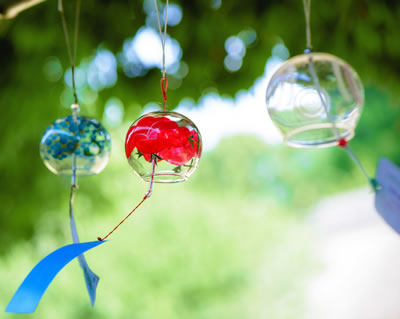
Atsui ne, “Isn’t it hot” has become a summer greeting here in Japan. Announcements on our televisions tell us to use air conditioning and drink lots of liquid to avoid heat stroke.
Even with these modern aids Japanese still use ancient traditional ways to give one a “feeling” of coolness.

But first let us look at feeling! Six months into Japanese language school we were introduced to a keyword in daily conversation. The word was kimochi. The dictionary lists translations such as feeling, mood, sensation, emotion, but warns that the word kimochi has multiple nuances according to text. Just one example: There are certain traditional ways to give one a cool kimochi in summer’s heat. The idea is that outside-of-self physical things can influence inside-one’s-self to give us a cool kimochi . The first cooling instrument is a furin or wind-bell. This is usually a fist-sized small bell made of tempered steel (at times glass) with a small stopper attached to a long, narrow piece of stiff paper. Even a gentle breeze will give us a melodious note, so creating a cool kimochi. My furin hangs by my bathroom window which I leave open. The gentle melody is soothing!
Another cool kimochi aid is a potted morning glory flower — especially light blue. This delicate touch of nature resonates in the heart to give us a feeling of coolness.
Another summer cooler is to watch goldfish swimming in their tank or to look at a painting of a goldfish or carp. There are many ancient scrolls of swimming fish.
I bought my first goldfish in 1957! One fish cost 10 yen, bought from a goldfish-man pushing a hand cart through the streets. Such a salesman is no longer with us. I bought my latest goldfish from a big pet shop for 150 yen. I find goldfish both relaxing and cooling!
The last summer cooler is a ghost story or painting. But despite a long tradition, here I draw the line! In Japan there is a deep residual fear of spirits or ghosts — as there was in the time of Jesus.
When Rome directed that the Japanese Mass text be closely transliterated from the Latin, for example the reply to the priest’s greeting “The Lord be with you,” from “And also with you” to “And with your spirit,” there was consternation among liturgists, linguists and even Roman trained bishops!
Spirit and ghost are the same word in Japanese. The Japanese bishops in unity ignored this directive. Our Bishop explained that people would be looking over the priest’s shoulder for a scary ghost! Ghost belief is alive in Japan! I tackle this deep-seated fear head on! I use Gospels showing how Jesus had power over evil spirits. I use especially the scene in Matthew 14:22- 33 where the disciples are in their sinking boat in a raging storm. They see in the mist someone walking on the water. In fear they cry out: ‘It is a ghost.” Jesus replies: “Fear not. It is I. Be not afraid.”
The Scriptures have an eternal present tense. The Risen Jesus says the same words of encouragement to us in a living voice today.
So let us be cool both in heart and body. But also let us consider why our summers are getting hotter because of global warming. Just what can each of us do in the concrete to keep our universe cool. This universe is our home. Let us care for it.
Columban Fr. Barry Cairns lives and works in Japan.